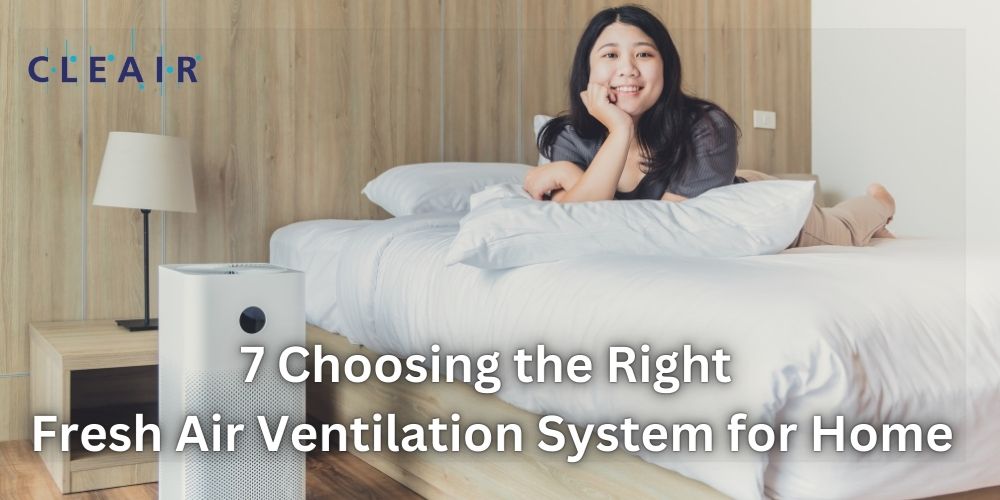
Choosing the Right Fresh Air Ventilation System for Home
Indoor air quality is critical in the pursuit of a healthy and comfortable living environment. Indoor air can contain a variety of pollutants and allergens, which can have a significant impact on our health and overall well-being. This is where a fresh air ventilation system for a Home can help.
Indoor air quality is essential for maintaining a healthy and comfortable living environment. Indoor air can contain a wide range of pollutants and allergens, which can have serious consequences for our health and overall well-being. A fresh air ventilation system can help in this situation.
7 Reasons While Choosing Fresh Air Ventilation System for a Home
- Assessing Your Indoor Air Quality Needs
When it comes to choosing a home fresh air ventilation system, one size does not fit all. The first step should be to evaluate your specific indoor air quality requirements. Consider the following:
There is no one-size-fits-all solution for indoor air quality. The first step in selecting the best fresh air system for your home is determining your specific indoor air quality requirements. Consider the following elements:
- Identify Your Concerns: Are there specific air quality issues in your home, such as high humidity, allergens, or persistent odors? Understanding your concerns will help pinpoint the right solution.
- Existing Ventilation: Take stock of any existing ventilation systems in your home. Are you starting from scratch, or do you have an existing HVAC setup? The compatibility of your new fresh air system with existing components is crucial.
- Occupancy and Habits: Consider the number of people living in your home and their habits. Larger households may require more significant ventilation capacity, while high-traffic areas may need special attention.
- Understanding Types of Fresh Air Systems
There are various types of fresh air systems, each with its own set of features and benefits. Understanding these types will assist you in making an informed decision:
- Heat Recovery Ventilators (HRV): HRVs are designed to recover heat from stale air and transfer it to fresh air coming in. They are ideal for cold climates because they can help you save money on heating while maintaining air quality.
- Energy Recovery Ventilators (ERV): ERVs are similar to HRVs in that they both transfer moisture. They’re great for keeping humidity levels balanced and are suitable for a variety of climates.
- Supply-Only Systems: Through dedicated vents, these systems bring fresh air into your home. They work well in homes with limited ventilation.
- Exhaust-Only Systems: These systems draw in fresh air by removing stale air from your home and creating negative pressure. They are less expensive than other types but may not provide the same level of control.
Each type has its own set of advantages and disadvantages, so it’s critical to select one that matches your indoor air quality goals and climate conditions.
Explore Cleair’s range of fresh air systems for improved indoor air quality and energy efficiency. Start your journey to healthier air with Cleair today.
- Sizing Your Fresh Air System
It is critical for the effectiveness of your fresh air system to choose the appropriate size. An undersized system may not provide adequate ventilation, whereas an oversized system may be inefficient. Take a look at the following:
- Identify Your Home’s Size: Start by determining the square footage of your home. Larger homes typically require more significant ventilation.
- Occupancy and Usage: The number of occupants and how you use various rooms matter. Kitchens, bathrooms, and bedrooms may have different ventilation needs.
- Climate: Consider your climate as it affects the need for heating and cooling. Colder climates may require HRVs or ERVs for heat recovery, while warmer climates might focus on energy efficiency.
- Energy Efficiency Considerations
Another important consideration when selecting a fresh air system is energy efficiency. An energy-efficient system not only saves money on utility bills, but it also contributes to a more environmentally friendly home. Consider the following factors:
- Heat Recovery Efficiency: HRVs and ERVs can recover and reuse heat, significantly reducing energy consumption.
- Energy-Efficient Components: Look for systems with energy-efficient fans and motors to further reduce electricity usage.
- Budget and Cost Considerations
While indoor air quality is critical, your budget will inevitably play a role in your decision. Fresh air systems are available at various price points, and installation costs must also be considered. Find a happy medium between your budget and the level of performance you require. - Maintenance and Longevity
Every fresh air system requires routine maintenance to ensure proper operation. Some systems may necessitate more maintenance than others. Think about your willingness and ability to perform routine maintenance. - Seeking Professional Guidance
Consulting with HVAC professionals or indoor air quality experts can provide useful information. They can assist you in determining your specific requirements, recommending the best system, and ensuring proper installation.
Conclusion
Finally, selecting the right fresh air system for your home is an important step towards creating a healthier and more comfortable living environment. You can make an informed decision that benefits your home and your family’s well-being by assessing your indoor air quality needs, understanding the different types of fresh air systems, correctly sizing your system, and considering factors such as energy efficiency and budget.
Ready to improve your indoor air quality? Explore Cleair’s range of fresh air systems and contact our experts for personalized guidance. Your journey to a healthier home starts here.


